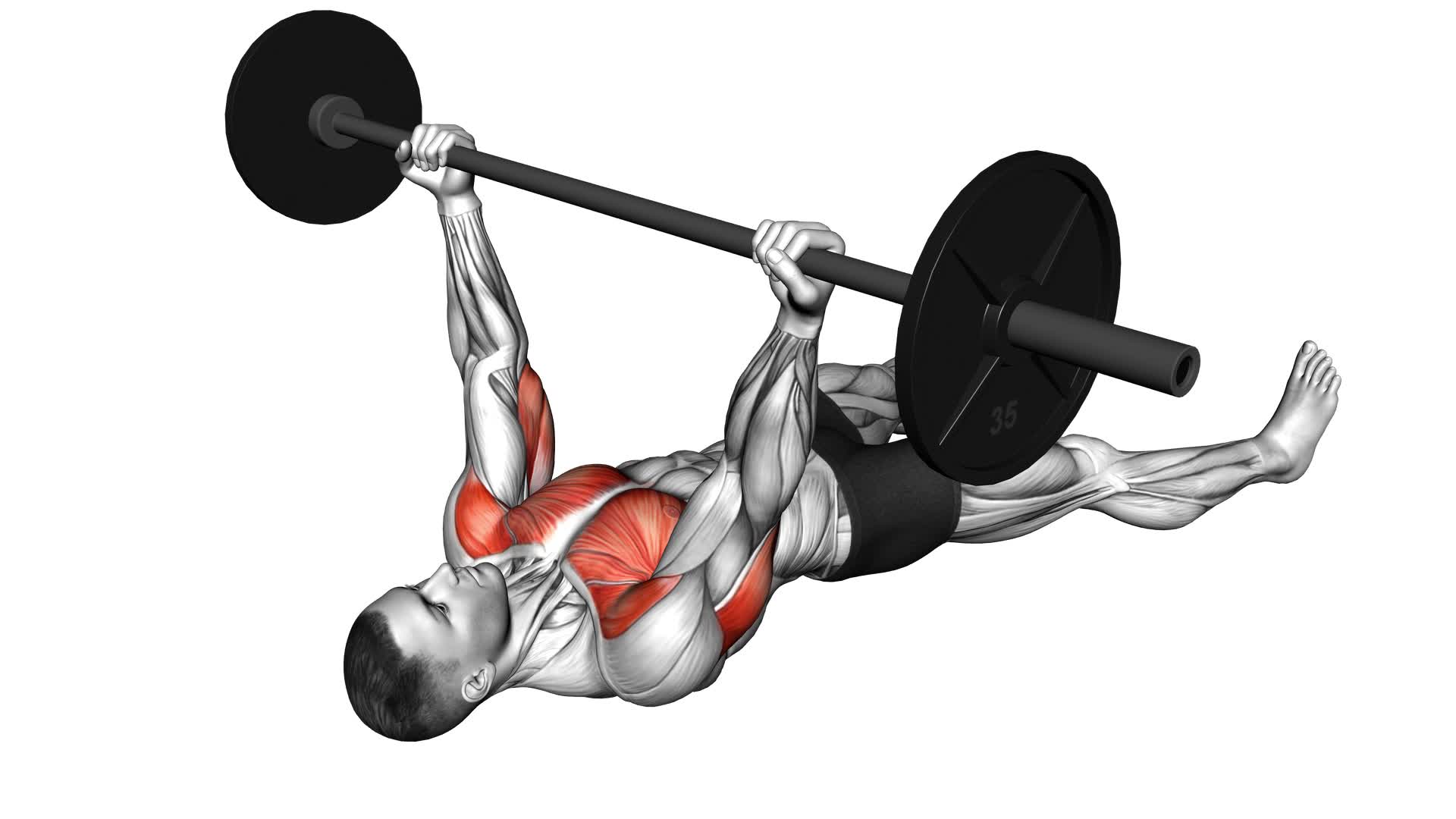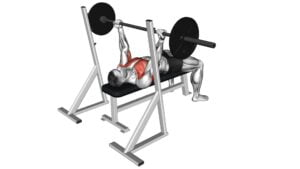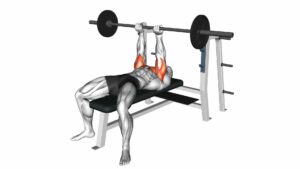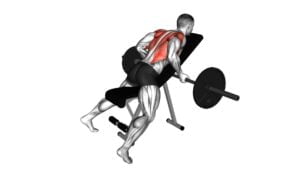Barbell Reverse Grip Bench Press on Floor – Video Exercise Guide & Tips

Are you looking for a new way to challenge your upper body strength? The Barbell Reverse Grip Bench Press on the floor might be just what you need.
Watch This Exercise Video
In this exercise, you'll be using a reverse grip to target different muscles and improve your overall strength.
With the help of this video exercise guide and some helpful tips, you'll be able to perform this exercise with proper form and technique.
Get ready to take your workout to the next level!
Key Takeaways
- Targets chest, shoulders, and triceps
- Emphasizes lower portion of chest for well-rounded and defined chest
- Engages shoulders as stabilizers
- Promotes overall upper body strength
Benefits of the Barbell Reverse Grip Bench Press
To maximize your strength gains and engage your chest, shoulders, and triceps, try incorporating the barbell reverse grip bench press into your workout routine. This variation of the bench press involves gripping the bar with your palms facing towards your face, instead of away from you. By doing so, you activate different muscles and target different areas of your upper body.
The barbell reverse grip bench press primarily targets your chest muscles, specifically the pectoralis major and minor. The reverse grip puts more emphasis on the lower portion of your chest, helping you develop a well-rounded and defined chest.
In addition, this exercise also engages your shoulders and triceps. The reverse grip places more stress on your triceps, allowing for greater muscle activation and development. Your shoulders act as stabilizers during the movement, contributing to overall upper body strength.
Equipment and Set-Up for the Exercise
To ensure optimal barbell positioning for the reverse grip bench press, it's important to set up the equipment correctly.
Start by lying on the floor with your feet flat and your knees bent.
Place the barbell directly above your chest, gripping it with a reverse grip, and ensuring that your hands are shoulder-width apart.
Maintaining proper form throughout the exercise is crucial for maximizing results and minimizing the risk of injury.
Optimal Barbell Positioning
Place the barbell on the floor directly above your chest, ensuring it's at a comfortable height for the exercise.
Here are four key factors to consider for optimal barbell positioning:
- Grip Width: Choose a grip width that allows for proper muscle activation. A wider grip targets the chest muscles more, while a narrower grip places more emphasis on the triceps.
- Hand Placement: Position your hands slightly wider than shoulder-width apart, ensuring your palms are facing towards you in a reverse grip. This grip puts more emphasis on the upper chest and shoulders.
- Barbell Alignment: Make sure the barbell is centered above your chest, ensuring equal weight distribution. This alignment promotes stability and prevents unnecessary strain on specific muscle groups.
- Chest Position: Maintain a slight arch in your lower back and keep your shoulder blades squeezed together. This position optimizes muscle activation and stability throughout the exercise.
Importance of Proper Form
Now let's delve into the importance of maintaining proper form and set-up for the exercise, focusing on your equipment and technique.
Posture plays a crucial role in the effectiveness and safety of the barbell reverse grip bench press on the floor. Ensuring proper alignment of your spine, shoulders, and hips not only reduces the risk of injury but also allows for optimal muscle engagement. When your posture is correct, you can generate more power and target the intended muscles more effectively.
Additionally, proper alignment helps distribute the load evenly, preventing excessive strain on any particular muscle group. By prioritizing good form and technique, you can maximize the benefits of this exercise and minimize the risk of injury.
Now, let's move on to discussing the proper form and technique for the exercise.
Proper Form and Technique for the Exercise
Set your feet firmly on the ground and grip the barbell with a reverse grip to maintain proper form and technique for the exercise. Here are four key tips to help you perform the barbell reverse grip bench press on the floor correctly:
- Start by lying flat on the floor with your legs extended and your knees bent. Place your feet hip-width apart and ensure they stay planted throughout the exercise. This will provide a stable base of support.
- Grasp the barbell with a reverse grip, which means your palms facing towards your face and your thumbs wrapped around the bar. This grip targets the muscles in your chest, shoulders, and triceps effectively.
- Lower the barbell slowly towards your chest, keeping your elbows tucked in close to your body. This helps engage your chest muscles and prevents unnecessary strain on your shoulders.
- Press the barbell back up to the starting position, exhaling as you exert force. Focus on driving through your chest and maintaining control throughout the movement.
Common Mistakes to Avoid
When performing the barbell reverse grip bench press on the floor, there are a few common mistakes to avoid.
First, make sure your elbows aren't too wide, as this can put unnecessary strain on your shoulders.
Second, maintain stability throughout the exercise by keeping your core engaged and your body in a straight line.
Lastly, ensure correct hand positioning by gripping the bar with your palms facing towards you and your thumbs wrapped around the bar.
Elbows Too Wide
To prevent making the common mistake of having elbows too wide during the barbell reverse grip bench press on the floor, focus on keeping your elbows close to your body. This will ensure proper elbows positioning and maximize muscle activation. Here are four key points to remember:
- Start with a shoulder-width grip on the barbell.
- As you lower the barbell, keep your elbows tucked in, pointing towards your sides.
- Avoid flaring your elbows outwards, as this can strain your shoulders and reduce stability.
- Engage your chest and triceps by pushing the barbell back up using the strength of your elbows and squeezing your chest muscles at the top.
By maintaining proper elbow positioning, you'll optimize muscle activation and minimize the risk of injury.
Now let's discuss the next common mistake: lack of stability.
Lack of Stability
To improve stability during the barbell reverse grip bench press on the floor, focus on maintaining a tight core and engaging your shoulder and chest muscles throughout the exercise. Stability training is crucial for this exercise as it helps you maintain control and prevent any unnecessary movement or wobbling.
By engaging your core, you create a solid foundation for your body, allowing you to lift the weight with more control and stability. Additionally, engaging your shoulder and chest muscles helps to stabilize the barbell and keep it in the correct position throughout the movement.
By incorporating these strategies into your workout, you can improve your overall stability and maximize the effectiveness of the exercise.
Now let's move on to the next common mistake to avoid, which is incorrect hand positioning.
Incorrect Hand Positioning
To avoid the common mistake of incorrect hand positioning during the barbell reverse grip bench press on the floor, ensure that your hands are positioned firmly on the barbell, slightly wider than shoulder-width apart.
Here are four common errors to avoid and tips for correct hand placement:
- Gripping the bar too wide: Placing your hands too far apart can strain your shoulders and limit your range of motion. Keep your hands just outside shoulder-width for optimal stability and control.
- Gripping the bar too close: On the other hand, gripping the bar too close together can put excessive stress on your wrists and elbows. Maintain a comfortable and balanced grip width to prevent discomfort or injury.
- Uneven hand placement: Make sure both hands are aligned symmetrically on the bar. Uneven hand placement can lead to imbalances in the movement and decrease overall effectiveness.
- Loose grip: Avoid letting your hands slide or lose their grip on the bar. Keep a tight and secure grip throughout the exercise to maintain control and prevent accidents.
Variations and Progressions for the Exercise
Explore different variations and progressions of the barbell reverse grip bench press on the floor to challenge your upper body strength and maximize your workout.
By incorporating variations into your routine, you can target different muscles and add variety to your training. One variation is the dumbbell reverse grip bench press, which involves using dumbbells instead of a barbell. This variation requires more stability and control, as each arm works independently.
Another option is the incline reverse grip bench press, where you adjust the bench to an incline position. This targets your upper chest and shoulders more intensely.
To progress the exercise, you can increase the weight you're lifting gradually. This will help you build strength and muscle over time. Additionally, you can experiment with different grip widths to target specific muscles. A wider grip will engage your chest and shoulders more, while a narrower grip will emphasize your triceps.
By incorporating these variations and progressions, you can continue challenging your muscles and making progress in your training.
Now, let's move on to some tips for getting the most out of your workout.
Tips for Getting the Most Out of Your Workout
To maximize your workout and get the most out of it, focus on using proper form and technique. Here are four tips for maximizing your workout intensity and maximizing results:
- Warm up properly: Before starting any workout, it's essential to warm up your muscles and prepare your body for the increased intensity. A proper warm-up can help prevent injuries and improve your overall performance.
- Increase the intensity gradually: It's tempting to go all out from the beginning, but it's important to gradually increase the intensity of your workouts. This allows your body to adapt and progress safely without risking overexertion or burnout.
- Incorporate compound exercises: Compound exercises engage multiple muscle groups simultaneously, making them more efficient for maximizing results. Exercises like squats, deadlifts, and bench presses are great examples of compound movements that can help increase workout intensity and stimulate muscle growth.
- Focus on proper nutrition and rest: A well-balanced diet and sufficient rest are crucial for maximizing the results of your workouts. Proper nutrition provides the fuel your body needs to perform at its best, while adequate rest allows for muscle recovery and growth.
Frequently Asked Questions
How Many Sets and Reps Should I Do for the Barbell Reverse Grip Bench Press?
To determine the optimal weight and progression for the barbell reverse grip bench press, you should start with a weight that challenges you but still allows for proper form. Aim for 3-4 sets of 8-12 reps, gradually increasing the weight as you get stronger.
Common mistakes to avoid include arching your back excessively, flaring your elbows out too much, and not fully extending your arms at the top.
Focus on maintaining control throughout the movement for optimal results.
Can I Use Dumbbells Instead of a Barbell for This Exercise?
Yes, you can use dumbbells instead of a barbell for the reverse grip bench press. Using dumbbells as an alternative to a barbell can provide several benefits.
Dumbbells allow for a greater range of motion and can help to improve stability and balance. Additionally, using dumbbells can help to target individual muscle groups more effectively.
Just be sure to choose a weight that's challenging but still allows you to maintain proper form throughout the exercise.
Is the Barbell Reverse Grip Bench Press Suitable for Beginners?
The barbell reverse grip bench press can be suitable for beginners if you focus on proper form and technique.
To perform this exercise, lie on the floor with a barbell in your hands, palms facing towards your face.
Lower the barbell to your chest, then push it back up to the starting position.
Be sure to keep your elbows close to your body and engage your chest muscles throughout the movement.
Avoid common mistakes like using too much weight or arching your back excessively.
Should I Use a Spotter When Performing This Exercise?
When performing the barbell reverse grip bench press, it's recommended to use a spotter for safety reasons. Having a spotter can help ensure that you maintain proper form and prevent any accidents or injuries.
While it's possible to perform the exercise without a spotter, it's always better to have someone there to assist you, especially if you're a beginner.
Additionally, using alternative equipment such as dumbbells or resistance bands can also be effective for this exercise.
Can This Exercise Help Improve My Tricep Strength?
Yes, the Barbell Reverse Grip Bench Press can certainly help improve your tricep strength. This exercise targets the triceps muscles effectively, leading to increased strength and muscle development.
However, it's always a good idea to incorporate a variety of exercises to fully maximize your tricep strength benefits. Some alternative exercises to consider include tricep dips, tricep pushdowns, and close grip bench press.
Remember to consult a fitness professional for proper form and technique.
Conclusion
In conclusion, the barbell reverse grip bench press is a beneficial exercise for targeting the muscles of the chest, shoulders, and triceps.
It can be done with minimal equipment and proper form is essential to avoid common mistakes.
Variations and progressions can be incorporated to further challenge and improve strength.
By following these tips, you can maximize the effectiveness of your workout and achieve optimal results.

Author
Years ago, the spark of my life’s passion ignited in my mind the moment I stepped into the local gym for the first time. The inaugural bead of perspiration, the initial endeavor, the very first surge of endorphins, and a sense of pride that washed over me post-workout marked the beginning of my deep-seated interest in strength sports, fitness, and sports nutrition. This very curiosity blossomed rapidly into a profound fascination, propelling me to earn a Master’s degree in Physical Education from the Academy of Physical Education in Krakow, followed by a Sports Manager diploma from the Jagiellonian University. My journey of growth led me to gain more specialized qualifications, such as being a certified personal trainer with a focus on sports dietetics, a lifeguard, and an instructor for wellness and corrective gymnastics. Theoretical knowledge paired seamlessly with practical experience, reinforcing my belief that the transformation of individuals under my guidance was also a reflection of my personal growth. This belief holds true even today. Each day, I strive to push the boundaries and explore new realms. These realms gently elevate me to greater heights. The unique combination of passion for my field and the continuous quest for growth fuels my drive to break new ground.







